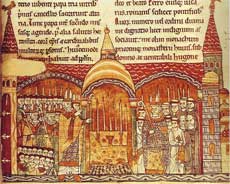Medieval Church
Organization of the Medieval Church
The Diocese - It was the administrative territorial unit of the Medieval Church. Administered by a Bishop, it was roughly based on the dioceses established under the Romans.
As the Medieval Church became more important, the dioceses received vast domains, often an entire province, and kings gave the bishops the right to govern their domain themselves.
The CathedralThe Chapters - The cathedral was the church of the seat of the diocese. Its priests were at first subjects to the bishops. From the 9th century they lived in clergy houses, or houses close to the cathedral, being subjects to an ecclesiastical rule, similar to that governing the monks, thus their name, canons (subjected to a rule). The ecclesiastical body comprising the canons formed the Chapter.

Pope Urban II Consecrating The Altar
at The Abbey of Cluny
Medieval Abbeys and the Church
Generally, a diocese contained several convents of monks. They observed the same rules, those of Saint Benedict, but each congregation formed an independent abbey, governed by an abbot. The abbey was a complex component of the Medieval Church, and consisted of the lodging of the monks, the residence of the abbot, the church, the hospice (where strangers were lodged), workshops, storehouses, the houses for the domestics and farmers. The abbot governed with the aid of the chapter of monks. In the great convents he also had other dignitaries under him, the provost, his deputy, the chamberlain, in charge of the clothing, the cellarer, in charge of the provisions, the treasurer, the librarian, the chorister, and the director of the school. The regulations of Saint Benedict required labor, and so, the monks were occupied with gardening, watching over the domestics, or making ornaments for the church.
Medieval ParishDuring the Middle Ages, the influence of the Church grew, and the feudal landowners, lords, abbots or bishops wanted to have chapels on their domains. The founding lord and his heirs had the right to recommend to the bishop the priest of that church. The priest took care of the souls of the village, and the territory administered by him formed a Parish. The inhabitants had to attend his church, and to obey him. The peasants had as their patron the saint of the church whose name was often given to the village itself, and the saint's day was the festive day of the village.
The Medieval Church and the interdict
The Medieval clergy were much better instructed than the laity, and by the 11th Century, bishops and abbots were detaining a large share of the political power. In times when everybody was a believer, the Church had the unique power of administering the sacraments, and no one wanted to be deprived of them.
Starting with the 11th century, the Church could employ the "interdict", meaning the withdrawal of church's sacraments. The clergy could deprive of the sacraments not only the lord, but all the people of his domains, and as a result, no one could be married or buried, and the church bells were not rung. The people were obliged to fast, and to let the hair grow as a sign of mourning.
Medieval feudal system and the Church
Using the Interdict, the clergy forced the lords to respect the laws of religion, and also prevent them from taking possession of any property of the Church. Through its own domains, the Church of the Middle Ages became now part of the feudal system. Bishops and abbots had to accept the obligations imposed by this system. They were vassals of the king, and they owed homage and military service to the sovereign. In Germany, the King's army was composed chiefly of knights brought by the Bishops and abbots. In France, sometimes, the King obliged the high ranking clergy of the Medieval French Church to come to the army in person.
